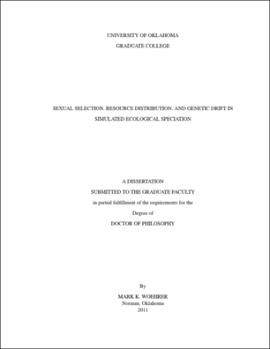| dc.contributor.advisor | Hougen, Dean F | |
| dc.creator | Woehrer, Mark Kevin | |
| dc.date.accessioned | 2019-04-27T21:35:43Z | |
| dc.date.available | 2019-04-27T21:35:43Z | |
| dc.date.issued | 2011 | |
| dc.identifier | 99319562202042 | |
| dc.identifier.uri | https://hdl.handle.net/11244/319094 | |
| dc.description.abstract | True interdisciplinary research is difficult to classify as belonging to one field or another. Many of the interesting research areas lie on the boundaries of our current research communities. By working on common interests biological and computational scientists can synergistically develop new forms of computation and models of biological phenomena. | |
| dc.description.abstract | Speciation is one of the most fundamental processes in evolutionary biology. This concept is largely unexplored and has yet to reach its full potential in artificial life, evolutionary computation, and evolutionary robotics investigations. Traditionally, speciation was mainly viewed as allopatric speciation. More recently, another mechanism of speciation has been studied that does not require geographic isolation. | |
| dc.description.abstract | This raises a number of interesting questions, some of which we are addressing in our simulation study. The first question is whether or not the existence of differences in resources will lead to divergence and speciation. Second, what is the role of female preferences? Would they potentially strengthen or weaken divergence? | |
| dc.description.abstract | Four hypotheses were formed and evaluated using the same experimental conditions in a simulated environment inspired by life on the Galapagos islands. In particular, the wet and dry season dynamics were modeled to produce the intense selection pressure found on the islands. Both large and small populations of seeds and hence large and small populations of birds were considered in our experiments. | |
| dc.description.abstract | Our results provide direct evidence for the proposed hypotheses. The most interesting case is when assortative mating is combined with uniform random seeds in which we found pseudo-speciation. With larger population sizes we found similar results with a reduced genetic drift component for the uniform seeds and assortative mating case. | |
| dc.description.abstract | In this dissertation we have addressed interesting questions related to mate selection in our ecological simulation and provided significant contributions with our work. By focusing on one phenotypic trait, we found that our simulated bird populations evolved specialized beaks for the food resources available and that sexual selection based on assortative mating was necessary for speciation. This research suggests to researchers in artificial life, evolutionary computation, and evolutionary robotics some of the mechanisms that may be utilized to foster artificial speciation. | |
| dc.format.extent | 161 pages | |
| dc.format.medium | application.pdf | |
| dc.language | en_US | |
| dc.relation.requires | Adobe Acrobat Reader | |
| dc.subject | Computational biology | |
| dc.subject | Species | |
| dc.subject | Natural selection | |
| dc.subject | Population genetics | |
| dc.title | Sexual Selection, Resource Distribution, and Genetic Drift in Simulated Ecological Speciation | |
| dc.type | text | |
| dc.type | document | |
| dc.thesis.degree | Ph.D. | |
| ou.group | College of Engineering::School of Computer Science | |
